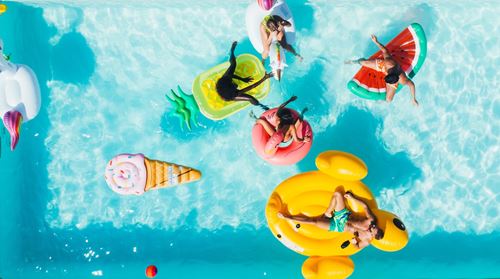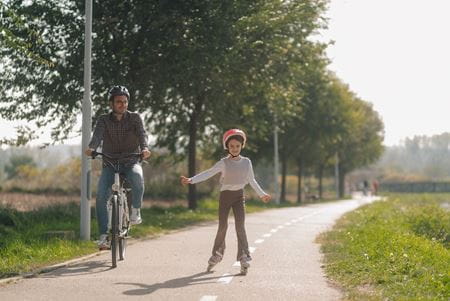Summertime means warm temperatures and long, sunny days with plenty of time for fun outdoor activities like backyard barbecues, swimming and biking. What’s not fun is a visit to the emergency room.
“As people get back outside to enjoy the warm weather, we start seeing many more orthopedic injuries, such as fractures and sprains, in the emergency department,” said Paige Ostahowski, MD, assistant professor of clinical emergency medicine at the Indiana University School of Medicine and EMS medical director at IU Health Methodist Hospital.
Those kinds of injuries — from activities like rollerblading, volleyball, trampolines or even golfing — are the top reason for summertime ER visits. Rounding out the top five, according to Ostahowski, are burns (thermal and sunburn), overheating, head injuries — often from riding bikes or ATVs without a helmet — and eye injuries from not wearing proper eye protection in the sun or while doing outdoor yardwork or other activities.
Ostahowski isn’t out to dampen summertime fun, but she advises people to consider safety precautions for each activity.
Fireworks
 Fireworks-related injuries peak on the Fourth of July and the days immediately preceding and following. According to the most recent U.S. Consumer Product Safety Commission report on Fireworks Injuries and Deaths, nearly 10,000 people are treated in emergency rooms each year for injuries from fireworks.
Fireworks-related injuries peak on the Fourth of July and the days immediately preceding and following. According to the most recent U.S. Consumer Product Safety Commission report on Fireworks Injuries and Deaths, nearly 10,000 people are treated in emergency rooms each year for injuries from fireworks.
“Kids and teens are generally most likely to get hurt,” Ostahowski said. “Most are burns to the hands, arms and legs. Holding fireworks in your hand while lighting them is a sure way to get a terrible hand injury and, in severe cases, can lead to amputation or limited use of the hand.”
While it might seem thrilling to hold a Roman candle as it fires, that’s a common way for devastating fireworks injuries to happen, she added. “So, best advice is to save the heroics for the movies and keep the fireworks on steady ground in a safe place where they won’t tip over.”
Grilling out
In recent years, attention has been brought to the risk of using grill brushes to remove greasy build-up from the grill grates. Metal bristles can dislodge from the brush and stick to grilled food, posing a risk of ingestion.
“I have not personally seen one of these cases, but there are several case reports that exist of patients accidentally swallowing a bristle from one of these brushes and having to seek medical attention to have it removed,” Ostahowski said. “I think that the best advice is to use a different type of brush if you need to clean off your grill. There are some bristle-less options that work great.”
But don’t skip cleaning the grill altogether because grease can cause flare-ups or fires. And grills should always be used in an open, well-ventilated area.
Camping and hiking
 “Remember that humans are not the only animals that like to get out when the weather gets warm,” Ostahowski said. “If you are enjoying a hike or biking outdoors, take precautions against ticks and other insects or animals by wearing appropriate clothing. Long pants will also protect against poison ivy and poison oak, which can be found hidden in wooded areas across the state.”
“Remember that humans are not the only animals that like to get out when the weather gets warm,” Ostahowski said. “If you are enjoying a hike or biking outdoors, take precautions against ticks and other insects or animals by wearing appropriate clothing. Long pants will also protect against poison ivy and poison oak, which can be found hidden in wooded areas across the state.”
When camping, keep food in an airtight container away from the tent to prevent wildlife from coming into the campsite in search of a meal, she added. When picnicking, keep cold food at or below 40 degrees Fahrenheit and hot food above 140 degrees, according to the FDA’s food safety guide for eating outdoors.
While hiking, be on the lookout for snakes. Indiana has four venomous species: the copperhead, cottonmouth (water moccasin), eastern massasauga rattlesnake and timber rattlesnake. Bites are rare and usually occur when someone tries to move a snake or accidently steps on one, according to the Indiana Department of Natural Resources.
Swimming and boating
Every year, about 4,000 people die from drowning in the U.S., and drowning is the leading cause of death in children ages 1 to 4.
“Many of the adult patients we see in the emergency department with water-related injuries also involve alcohol or other substances,” Ostahowski said. “In kids, injuries tend to happen when there isn't adequate supervision. This is when children, especially toddlers and younger kids, end up in the deep end of the pool or in an area that exceeds their swimming level and drown.”
Caregivers need to be vigilant in supervising children, and everyone should wear a life jacket when on open water, she added.
Sun exposure
 Spending time outdoors in high temperatures can lead to several potential hazards including heat exhaustion and sunburn. Heat stroke is a life-threatening condition caused by the body overheating that’s marked by dizziness, fainting, blurred vision, slurred speech and confusion.
Spending time outdoors in high temperatures can lead to several potential hazards including heat exhaustion and sunburn. Heat stroke is a life-threatening condition caused by the body overheating that’s marked by dizziness, fainting, blurred vision, slurred speech and confusion.
“You can get overheated even when not exerting yourself to excess when the temperature gets as high as it does in Indiana,” Ostahowski said. “Make sure you are hydrating if you are going to be in the heat for any reason.”
As with drowning and several other summer-related injuries, heat injuries commonly happen in the presence of alcohol and other mind-altering substances, she noted.
In addition to hydration, sunscreen is essential for all outdoor activities. Burns can happen even on cloudy days.
“Not only do sunburns make you miserable the day after, but each sunburn increases the risk of skin cancer later in life,” Ostahowski said.
Biking, skating & ATVs
Freewheeling through summer might sound cool, but anytime a person is on wheels, it’s important to wear a helmet.
 “Head injuries are definitely one of the most terrible injuries that can happen,” Ostahowski said. “During the warm months, we see more of them because people are out doing fun things like riding their motorcycles and bicycles. The best prevention for this type of injury, if you are going to engage in these activities, is to wear a helmet.”
“Head injuries are definitely one of the most terrible injuries that can happen,” Ostahowski said. “During the warm months, we see more of them because people are out doing fun things like riding their motorcycles and bicycles. The best prevention for this type of injury, if you are going to engage in these activities, is to wear a helmet.”
Bicyclist deaths are highest in urban areas and during the summer months between June and September, according to the National Highway Traffic Safety Administration, which offers bicycle safety tips for both cyclists and drivers. Always obey traffic rules and stay visible with bright clothing and reflective materials.
Over the years, Ostahowski has seen some terrible injuries from summertime activities that could have been prevented by taking proper safety precautions.
“Bumps and bruises are going to happen,” she said, “but being smart about the activities that you are involved in will mitigate most injuries.”
